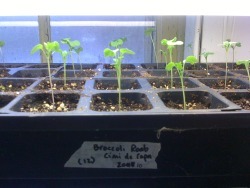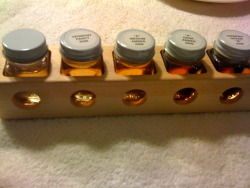 The seed room is nearly vibrating with life. We've got hundred of little baby plants shooting into the light, and I think we're all a little giddy from it. After a lovely, quiet, snowy winter, the seedlings are the embodiment of new life, and they are feast for our eyes and our imaginations.
The seed room is nearly vibrating with life. We've got hundred of little baby plants shooting into the light, and I think we're all a little giddy from it. After a lovely, quiet, snowy winter, the seedlings are the embodiment of new life, and they are feast for our eyes and our imaginations.
In the span of less than a week, the tiny seedlings have grown enough to be transplanted into larger containers filled with potting soil, which will sustain them for the next month or so until they get into the ground.
Above are tiny seedlings of a Swiss Chard variety called "Bright Lights," after its colorful appearance. Red, pink, and yellow, this chard's stems are so attractive when they're fully grown.

You can see how delicate the stems are at this stage, just wisps of green, shooting toward the light. After the plants first emerge, they send out little neo-leaves called "cotyledon." This is actually an embryonic leaf, already present in the seed itself. After the seed germinates, or sprouts, true leaves are formed. And after the first set of true leaves emerge, it's time to transplant.

When the weather gets a little bit warmer, we'll start the "hardening off" process, which means bringing these plants out into the fresh air during the day, and then back into the barn in the evening to protect them from the cool night temperatures.
But before then, we've got peas to plant and maple sugaring to do. Peas are planted traditionally on March 17, if possible. Maple sugaring is going full steam right now, with this weekend's temps in the 40s and today projected to be 55. Yesterday, we gathered more than 100 gallons of sap, and we'll hopefully get another good amount today. With the weather turning to such extremes this past year, we don't know how long the sap will run, so we're making the most of it while we can.

It's just warm enough to go without a jacket, and it seems that everything wants to stretch and move, including little seedlings and the sap within trees. We're so lucky that we can play a role in cultivating that movement in such healthy and tasty directions.